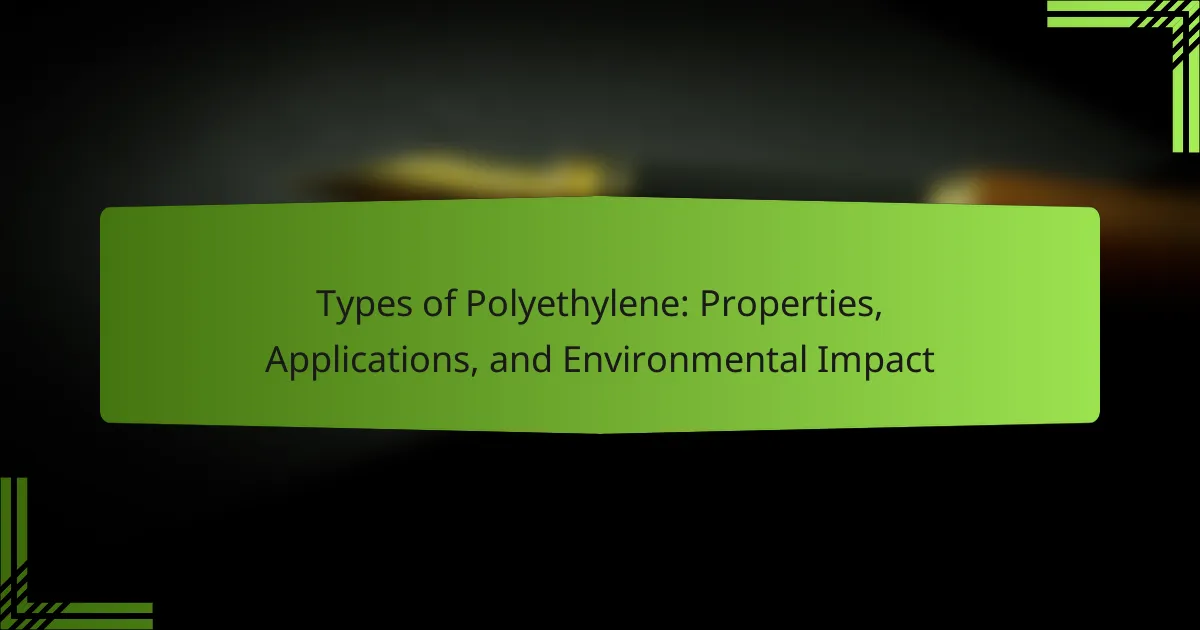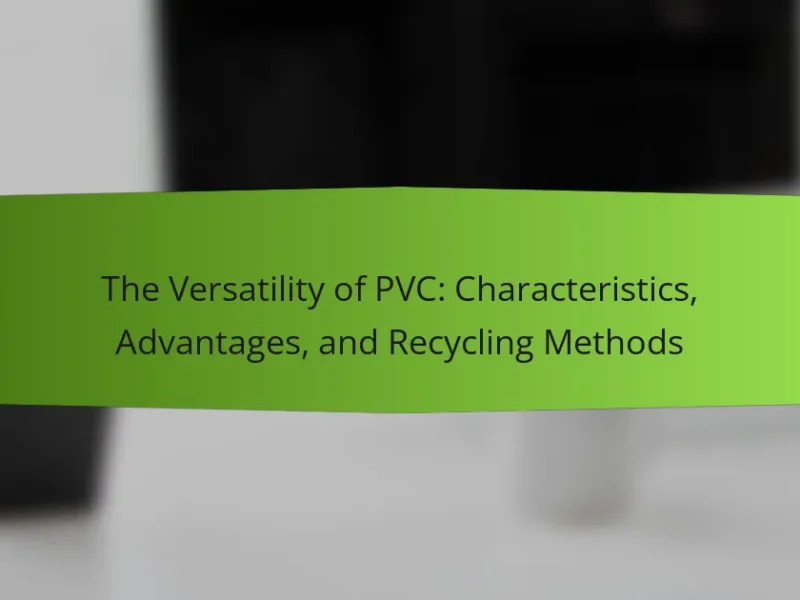Polyethylene is a widely used plastic with various types, including Low-Density Polyethylene (LDPE), High-Density Polyethylene (HDPE), Linear Low-Density Polyethylene (LLDPE), and Ultra-High Molecular Weight Polyethylene (UHMWPE), each possessing distinct properties and applications. LDPE is flexible and used in plastic bags, while HDPE is stronger and utilized for containers and pipes. The environmental impact of polyethylene is significant, as it is non-biodegradable and contributes to pollution, with millions of tons entering oceans annually. Efforts to recycle polyethylene are limited, but sustainable practices, including recycling and biopolymer alternatives, can help reduce its ecological footprint and greenhouse gas emissions.
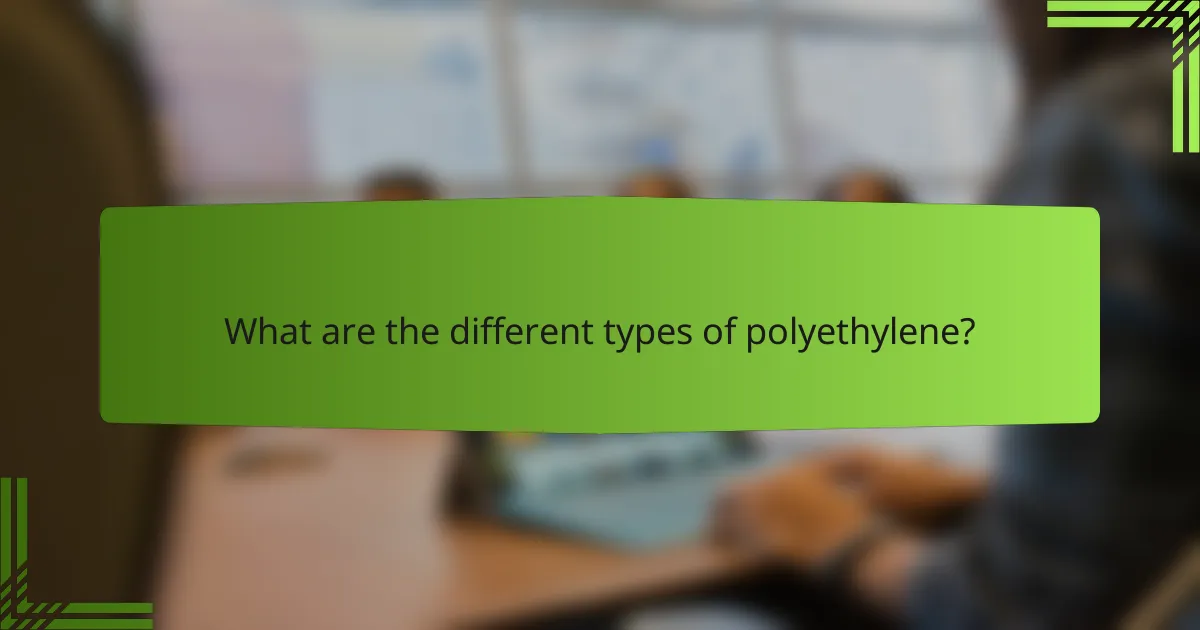
What are the different types of polyethylene?
The different types of polyethylene include Low-Density Polyethylene (LDPE), High-Density Polyethylene (HDPE), Linear Low-Density Polyethylene (LLDPE), and Ultra-High Molecular Weight Polyethylene (UHMWPE). LDPE is known for its flexibility and low-density structure. HDPE offers higher strength and rigidity. LLDPE combines properties of both LDPE and HDPE, providing better tensile strength. UHMWPE has extremely high molecular weight, giving it exceptional impact resistance. Each type has unique applications based on its properties. For example, LDPE is commonly used in plastic bags, while HDPE is used for containers and pipes.
How is polyethylene classified?
Polyethylene is classified primarily into three categories: low-density polyethylene (LDPE), high-density polyethylene (HDPE), and linear low-density polyethylene (LLDPE). LDPE has a branched structure, resulting in a lower density and increased flexibility. HDPE features a more linear structure, leading to higher density and greater tensile strength. LLDPE is a copolymer that combines properties of both LDPE and HDPE, offering enhanced strength and elasticity. These classifications are based on the molecular structure and density of the polymer. The differences in structure and density influence their properties and applications, such as in packaging, containers, and plastic films.
What are the characteristics of low-density polyethylene (LDPE)?
Low-density polyethylene (LDPE) is a thermoplastic made from the polymerization of ethylene. It is known for its flexibility and low-density structure. LDPE has a low tensile strength and is less rigid compared to other types of polyethylene. It is resistant to impact and has good chemical resistance. LDPE is also translucent and has a low melting point, typically around 105-115°C. It is commonly used in plastic bags, containers, and shrink wraps. The material’s properties make it suitable for applications requiring flexibility and durability. LDPE’s molecular structure contributes to its unique characteristics, allowing it to be easily processed and molded.
What are the characteristics of high-density polyethylene (HDPE)?
High-density polyethylene (HDPE) is a thermoplastic polymer characterized by its high strength-to-density ratio. It exhibits excellent tensile strength, making it resistant to impact and stress. HDPE is known for its durability and resistance to various chemicals, including acids and bases. It has a melting point of approximately 120-180°C, allowing it to withstand high temperatures. The material is lightweight yet robust, contributing to its wide range of applications. HDPE is also recyclable, classified as a #2 plastic, which promotes environmental sustainability. Its low moisture absorption enhances its performance in outdoor applications.
What are the characteristics of linear low-density polyethylene (LLDPE)?
Linear low-density polyethylene (LLDPE) is a thermoplastic polymer characterized by its flexibility and toughness. It has a low-density structure, which allows for high elongation and impact resistance. LLDPE features a linear backbone with short branches, contributing to its unique properties. This configuration results in improved tensile strength compared to low-density polyethylene (LDPE).
LLDPE exhibits excellent resistance to chemicals and moisture, making it suitable for various applications. Its melting point typically ranges from 120 to 130 degrees Celsius. Additionally, LLDPE is known for its ability to be processed easily through methods like extrusion and blow molding.
The material is commonly used in packaging films, containers, and agricultural applications due to its durability. Its versatility is further enhanced by its compatibility with additives and colorants.
What are the characteristics of ultra-high-molecular-weight polyethylene (UHMWPE)?
Ultra-high-molecular-weight polyethylene (UHMWPE) is a type of polyethylene characterized by its extremely long molecular chains. This structure results in exceptional strength and durability. UHMWPE exhibits high resistance to abrasion and impact. It also has low friction properties, making it suitable for various applications. The material is chemically inert, which allows it to resist corrosion from many substances. UHMWPE has a very low moisture absorption rate, contributing to its stability in wet environments. Additionally, it can withstand a wide range of temperatures, maintaining performance in both low and high heat conditions. These characteristics make UHMWPE ideal for use in medical devices, industrial applications, and protective gear.
What are the main properties of polyethylene?
Polyethylene is a versatile polymer known for its key properties. It exhibits excellent chemical resistance, making it suitable for various applications. Polyethylene has a low density, which contributes to its lightweight nature. It also demonstrates good impact resistance, allowing it to withstand physical stress. The material is flexible, facilitating its use in packaging and containers. Polyethylene has a high tensile strength, which enhances its durability. Its low moisture absorption minimizes the risk of degradation. Additionally, it is non-toxic and recyclable, aligning with environmental sustainability. These properties make polyethylene widely used in industries such as packaging, construction, and consumer goods.
How does the molecular structure influence polyethylene’s properties?
The molecular structure of polyethylene directly influences its properties. Polyethylene consists of long chains of repeating ethylene units. The arrangement of these chains affects characteristics like density and strength. For instance, high-density polyethylene (HDPE) has a more linear structure, resulting in higher tensile strength. In contrast, low-density polyethylene (LDPE) features a branched structure, leading to increased flexibility. The degree of crystallinity in polyethylene also varies with its molecular structure. More crystalline polyethylene exhibits enhanced rigidity and chemical resistance. These structural variations are critical in determining the applications of polyethylene in packaging, containers, and other products.
What are the thermal properties of polyethylene?
Polyethylene has specific thermal properties that define its behavior under heat. Its melting point ranges from 105 to 130 degrees Celsius, depending on the density and type. Polyethylene exhibits low thermal conductivity, making it a poor heat conductor. The thermal expansion coefficient of polyethylene is approximately 100 to 200 x 10^-6 per degree Celsius. This means it expands when heated and contracts when cooled. Polyethylene can withstand temperatures up to 80 degrees Celsius for prolonged periods without significant degradation. Above this temperature, it may begin to soften and lose structural integrity. These properties make polyethylene suitable for various applications in packaging and insulation.
What are the mechanical properties of polyethylene?
Polyethylene has several key mechanical properties. It exhibits high tensile strength, typically ranging from 20 to 37 MPa. Polyethylene is also known for its excellent impact resistance. This material can withstand significant stress without breaking. The elongation at break for polyethylene can reach up to 700%. Its hardness is measured on the Shore D scale, generally between 40 and 60. Polyethylene also has a low coefficient of friction, making it suitable for various applications. Additionally, it maintains flexibility at low temperatures. These properties make polyethylene a versatile choice for many industrial applications.
What applications utilize different types of polyethylene?
Different types of polyethylene are utilized in various applications. Low-Density Polyethylene (LDPE) is commonly used for plastic bags, containers, and packaging films. High-Density Polyethylene (HDPE) is often found in bottles, piping, and industrial containers. Linear Low-Density Polyethylene (LLDPE) is used for stretch films and flexible packaging. Polyethylene Terephthalate (PET) is widely used in beverage bottles and food containers. Cross-Linked Polyethylene (PEX) is primarily employed in plumbing and heating systems. Each type serves specific functions based on its unique properties, such as flexibility, strength, and chemical resistance.
How is LDPE used in packaging materials?
LDPE is commonly used in packaging materials due to its flexibility and durability. It is often utilized to create plastic bags, shrink wraps, and food packaging. LDPE’s low-density structure provides excellent moisture resistance. This makes it an ideal choice for packaging perishable goods. The material is lightweight, which reduces shipping costs. LDPE is also recyclable, contributing to environmental sustainability. Its versatility allows for various applications in both consumer and industrial packaging. According to the Plastics Industry Association, LDPE accounts for a significant portion of the flexible packaging market.
What industries commonly use HDPE?
The industries that commonly use HDPE include packaging, construction, and automotive. In packaging, HDPE is utilized for making bottles, containers, and bags due to its durability and resistance to chemicals. The construction industry employs HDPE for piping, geomembranes, and plastic lumber because of its strength and longevity. In the automotive sector, HDPE is used in fuel tanks and interior components because of its lightweight and impact resistance. These applications demonstrate HDPE’s versatility and effectiveness across various industries.
How is LLDPE applied in agricultural films?
LLDPE is applied in agricultural films primarily due to its flexibility and durability. These films are used for greenhouse covers, mulch films, and silage wraps. LLDPE provides excellent tensile strength, which helps in withstanding environmental stresses. Its UV resistance protects crops from harmful sunlight. The material is also lightweight, making it easy to handle and install. Additionally, LLDPE films are effective in moisture retention, promoting healthier plant growth. Studies show that LLDPE films can enhance crop yield by creating optimal growing conditions.
What are the medical applications of UHMWPE?
UHMWPE, or Ultra-High Molecular Weight Polyethylene, has several medical applications. It is widely used in orthopedic implants, particularly in hip and knee replacements. The material’s high wear resistance contributes to the longevity of these implants. UHMWPE is also utilized in surgical sutures and meshes due to its biocompatibility. Additionally, it serves in the manufacturing of prosthetic devices. Studies have shown that UHMWPE can reduce friction and wear in joint applications. Its use in medical devices is supported by extensive research demonstrating its effectiveness and safety.
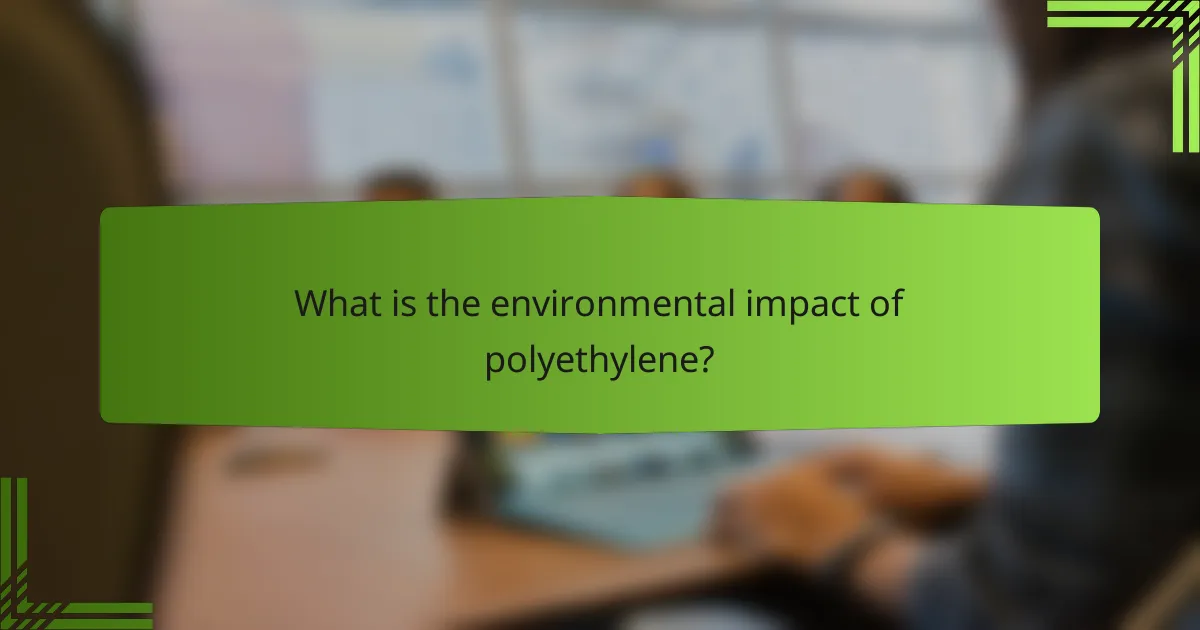
What is the environmental impact of polyethylene?
Polyethylene has significant environmental impacts primarily due to its persistence in the environment. It is not biodegradable, leading to long-lasting pollution in landfills and oceans. Approximately 8 million tons of plastic waste enter oceans annually, with polyethylene being a major contributor. This accumulation harms marine life, as animals can ingest or become entangled in plastic debris. Additionally, the production of polyethylene generates greenhouse gases, contributing to climate change. Studies indicate that plastic production and incineration release around 850 million metric tons of greenhouse gases each year. Efforts to recycle polyethylene are limited, with only about 9% of plastic waste being recycled globally. This low recycling rate exacerbates its environmental footprint.
How does polyethylene affect the environment?
Polyethylene negatively impacts the environment primarily through pollution and waste. It is a widely used plastic that is not biodegradable. As a result, polyethylene products can persist in ecosystems for hundreds of years. This longevity leads to accumulation in landfills and oceans. Microplastics from polyethylene break down into smaller particles, harming marine life. Studies indicate that these particles can enter the food chain, affecting both wildlife and human health. Additionally, the production of polyethylene contributes to greenhouse gas emissions. The extraction of fossil fuels for its production further exacerbates environmental degradation.
What are the challenges of polyethylene waste management?
The challenges of polyethylene waste management include its durability and low biodegradability. Polyethylene can take hundreds of years to decompose in the environment. This persistence leads to accumulation in landfills and oceans. Recycling rates for polyethylene are low, often below 30%. Contamination of recyclable materials further complicates the recycling process. Additionally, the lack of infrastructure for proper disposal and recycling exacerbates the issue. Public awareness and education about polyethylene waste are often insufficient. These factors collectively hinder effective waste management strategies for polyethylene.
How does polyethylene contribute to pollution?
Polyethylene contributes to pollution primarily through its persistence in the environment. It is a non-biodegradable plastic that can take hundreds of years to decompose. When discarded improperly, polyethylene products accumulate in landfills and natural habitats. This accumulation leads to soil and water contamination. Microplastics, resulting from the breakdown of polyethylene, can enter the food chain. Studies show that marine life often ingests these microplastics, causing harm to ecosystems. Additionally, the production of polyethylene releases greenhouse gases, contributing to climate change.
What are the recycling options for polyethylene?
Polyethylene can be recycled through various methods. The most common recycling options include mechanical recycling, chemical recycling, and energy recovery.
Mechanical recycling involves physically breaking down the plastic into smaller pieces. This process allows for the creation of new products made from recycled polyethylene.
Chemical recycling, on the other hand, breaks down polyethylene into its original monomers. This method allows for the production of virgin-quality polyethylene from recycled materials.
Energy recovery involves converting polyethylene waste into energy through processes like incineration. This method is often used when recycling is not feasible.
According to the Association of Plastic Recyclers, approximately 30% of polyethylene is recycled in the U.S. This highlights the importance of recycling options available for this widely used plastic.
What processes are used to recycle polyethylene?
The processes used to recycle polyethylene include mechanical recycling, chemical recycling, and energy recovery. Mechanical recycling involves shredding the plastic into small pieces, washing, and then reprocessing it into new products. Chemical recycling breaks down polyethylene into its monomers or other chemicals, allowing for the creation of new polyethylene. Energy recovery involves incinerating polyethylene to generate energy, though this is less common due to emissions concerns. According to the Plastics Industry Association, mechanical recycling is the most widely used method, as it conserves resources and reduces landfill waste.
What are the benefits of recycling polyethylene?
Recycling polyethylene reduces environmental impact by minimizing waste in landfills. It conserves natural resources by decreasing the need for virgin materials. Recycling also saves energy; it requires less energy than producing new polyethylene. According to the EPA, recycling one ton of plastic can save 7.4 cubic yards of landfill space. Additionally, it lowers greenhouse gas emissions, contributing to climate change mitigation. The recycling process generates economic benefits by creating jobs in the recycling and manufacturing sectors. Overall, these benefits highlight the importance of recycling polyethylene for sustainability.
How can we minimize the environmental impact of polyethylene?
To minimize the environmental impact of polyethylene, we can implement several strategies. Reducing production levels can decrease resource extraction and energy consumption. Increasing recycling rates helps divert polyethylene from landfills. Utilizing biodegradable alternatives can lessen long-term pollution. Encouraging the use of recycled materials in manufacturing can reduce the need for virgin polyethylene. Implementing stricter regulations on plastic waste can drive innovation in sustainable practices. Investing in research for more eco-friendly materials can lead to better solutions. Educating consumers about responsible usage and disposal can increase awareness and participation in sustainability efforts.
What alternatives to polyethylene are available?
Biodegradable plastics are alternatives to polyethylene. These materials decompose more quickly in the environment. Examples include polylactic acid (PLA) and polyhydroxyalkanoates (PHA). PLA is derived from renewable resources like corn starch. PHA is produced by microbial fermentation of sugars or lipids. Both options reduce plastic waste and environmental impact. Additionally, paper and cardboard can serve as sustainable packaging alternatives. These materials are recyclable and biodegradable. Each alternative presents unique properties and applications.
What practices can reduce polyethylene usage in industries?
Implementing alternative materials can significantly reduce polyethylene usage in industries. Many businesses are shifting to biodegradable materials. These materials often have similar properties to polyethylene but are more environmentally friendly. Adopting reusable packaging is another effective practice. This reduces the need for single-use polyethylene products. Additionally, enhancing recycling programs can help minimize polyethylene waste. Industries can also invest in innovative technologies for material substitution. Education and awareness campaigns can encourage sustainable practices among consumers. These strategies collectively contribute to reducing polyethylene reliance in various sectors.
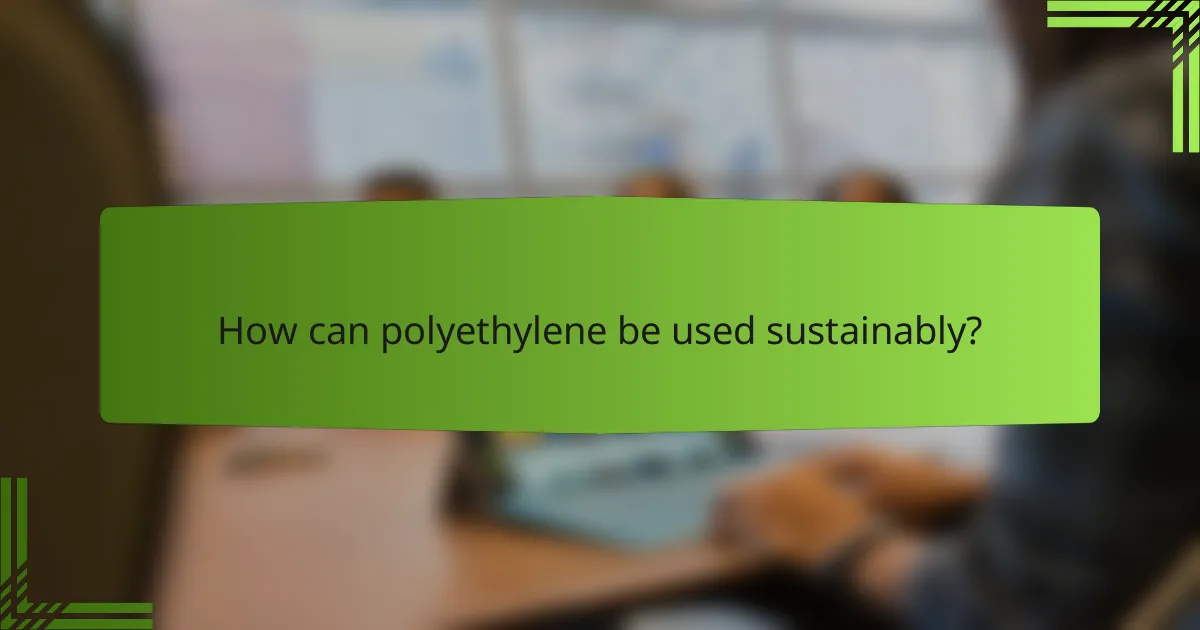
How can polyethylene be used sustainably?
Polyethylene can be used sustainably through recycling and biopolymer alternatives. Recycling polyethylene reduces waste and conserves resources. Approximately 30% of polyethylene is currently recycled in various regions. Biopolymer alternatives, derived from renewable resources, can replace traditional polyethylene. These alternatives can biodegrade and minimize environmental impact. Additionally, using recycled polyethylene in manufacturing decreases energy consumption by up to 88%. Sustainable practices in production can also lower greenhouse gas emissions. Implementing these methods supports a circular economy and reduces reliance on fossil fuels.
What strategies promote sustainable polyethylene use?
Strategies that promote sustainable polyethylene use include recycling, reducing consumption, and using bio-based alternatives. Recycling polyethylene helps to minimize waste and conserve resources. It is estimated that recycling can reduce greenhouse gas emissions by up to 30%. Reducing consumption involves minimizing single-use plastics and encouraging reusable products. This approach can significantly lower the demand for new polyethylene production. Using bio-based polyethylene, derived from renewable resources, can decrease reliance on fossil fuels. Studies indicate that bio-based polyethylene can reduce carbon emissions by 50% compared to traditional polyethylene. Implementing these strategies collectively contributes to a more sustainable polyethylene lifecycle.
How can manufacturers implement eco-friendly practices?
Manufacturers can implement eco-friendly practices by adopting sustainable production methods. This includes using renewable energy sources, such as solar or wind power. They can also reduce waste through recycling and reusing materials. Implementing efficient resource management minimizes water and energy consumption. Manufacturers should choose eco-friendly materials, like biodegradable plastics or recycled content. Additionally, they can optimize logistics to reduce carbon emissions during transportation. According to the Ellen MacArthur Foundation, transitioning to a circular economy can significantly lower environmental impact.
What role do consumers play in sustainable polyethylene use?
Consumers play a crucial role in sustainable polyethylene use. Their purchasing decisions influence demand for eco-friendly products. By choosing products made from recycled polyethylene, consumers promote recycling initiatives. Additionally, consumers can reduce plastic waste through proper disposal and recycling practices. Awareness of environmental impacts encourages consumers to support brands committed to sustainability. Education on the benefits of sustainable polyethylene can drive more responsible consumer behavior. Ultimately, informed consumers can push for industry changes towards more sustainable practices.
What are the best practices for polyethylene disposal?
The best practices for polyethylene disposal include recycling, proper waste segregation, and utilizing designated disposal facilities. Recycling polyethylene helps reduce landfill waste and conserves resources. Many communities offer curbside recycling programs specifically for plastics. Proper waste segregation ensures that polyethylene does not contaminate other recyclable materials. Utilizing designated disposal facilities allows for safe and environmentally friendly handling of polyethylene waste. According to the Environmental Protection Agency, recycling one ton of plastic can save 7.4 cubic yards of landfill space.
How can individuals properly dispose of polyethylene products?
Individuals can properly dispose of polyethylene products by recycling them when possible. Many polyethylene products, such as bags and containers, are recyclable. Check local recycling guidelines to confirm which types are accepted. Clean and dry the polyethylene items before recycling to ensure they meet processing standards. If recycling is not available, consider reusing polyethylene products to extend their life. If neither option is viable, dispose of them in general waste. According to the Environmental Protection Agency, recycling can significantly reduce landfill waste and conserve resources.
What community initiatives support polyethylene recycling?
Community initiatives that support polyethylene recycling include local recycling programs and educational campaigns. Many municipalities have established curbside collection for polyethylene products. These programs encourage residents to recycle plastic bags and containers. Schools often participate in educational initiatives about the importance of recycling. Community workshops also teach proper recycling practices. Non-profit organizations may host clean-up events that promote recycling awareness. Additionally, partnerships with local businesses can enhance recycling efforts. These initiatives collectively aim to reduce plastic waste and promote sustainable practices.
The main entity of this article is polyethylene, a versatile polymer with various types including Low-Density Polyethylene (LDPE), High-Density Polyethylene (HDPE), Linear Low-Density Polyethylene (LLDPE), and Ultra-High Molecular Weight Polyethylene (UHMWPE). The article outlines the properties, applications, and environmental impacts of these polyethylene types, detailing their unique characteristics and common uses in industries such as packaging, construction, and medicine. It also addresses the challenges of polyethylene waste management, recycling options, and strategies for sustainable use, emphasizing the importance of reducing environmental impact through responsible practices and consumer choices.
